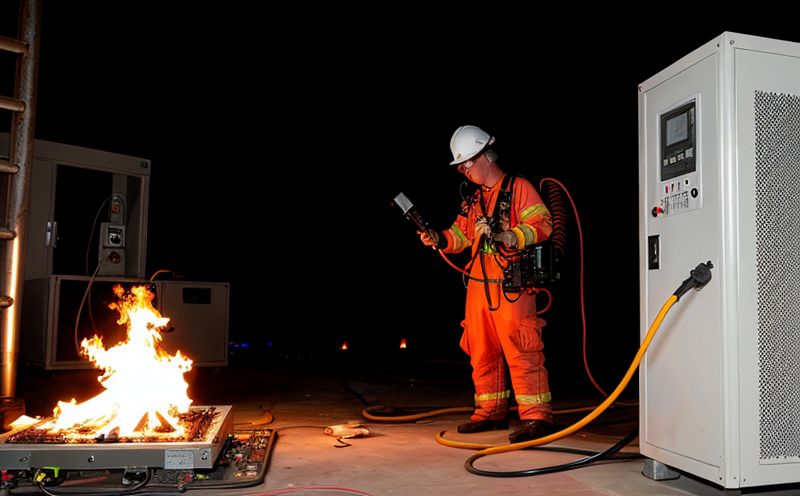Full Compliance Assessment with EN and IEC Fire Standards
The full compliance assessment service using European Norm (EN) and International Electrotechnical Commission (IEC) fire standards is a comprehensive approach to ensuring that electrical and electronic equipment meet the stringent safety requirements set by these global regulatory bodies. This service is crucial for manufacturers, quality managers, and R&D engineers who need assurance that their products are safe under various conditions.
Fire safety testing in this context involves evaluating materials, components, assemblies, and complete systems to ensure they can withstand exposure to fire without causing catastrophic failure or posing a risk to human life. The standards focus on both the performance characteristics of materials during fire as well as the overall design and construction of products that incorporate these materials.
EN 60335-2 and IEC 60335-2 are particularly relevant for small electrical appliances, while EN 61032 and IEC 61032 cover electronic components. These standards include tests such as the Horizontal Burning Test (HBT), Vertical Burning Test (VBT), Flame Spread Index (FSI) measurement, and other related procedures designed to assess how materials behave in a fire environment.
For R&D engineers, this service provides critical insights into material selection, design optimization, and manufacturing processes that can enhance product safety. Compliance with these standards is not just about avoiding penalties but also about building consumer trust and ensuring regulatory compliance across international markets. The growing trend towards sustainable materials and energy-efficient designs further emphasizes the importance of rigorous fire testing.
Quality managers and procurement professionals benefit from this service by gaining assurance that suppliers meet the highest safety standards, thus mitigating risks associated with non-compliant products entering the supply chain. This ensures that all stakeholders are aligned in their pursuit of product excellence and regulatory adherence.
The process typically involves detailed specimen preparation based on specific test requirements outlined in the relevant standards. Specimens are then subjected to controlled fire environments where they undergo rigorous testing under various conditions such as time, temperature, and flame exposure levels. Instruments like thermocouples, calorimeters, and data loggers capture critical performance metrics during these tests.
Upon completion of the tests, detailed reports are generated summarizing all findings along with recommendations for improvements if necessary. These reports serve multiple purposes including internal documentation, external audits, and potential modifications to product designs or manufacturing processes.
The importance of compliance cannot be overstated; it ensures that products not only meet but exceed safety expectations set forth by international bodies. By adhering strictly to these standards, manufacturers demonstrate their commitment to protecting end users and contributing positively to public health and safety.
Why Choose This Test
- Maintains international standards ensuring global market access.
- Provides detailed insights into product performance under fire conditions.
- Safeguards against potential legal and financial penalties associated with non-compliance.
- Elevates brand reputation by demonstrating commitment to safety and quality.
The service is chosen for its ability to provide robust evidence of compliance, thereby facilitating smoother market entry into Europe and other regions adopting EN and IEC standards. It also helps in identifying areas where improvements can be made, leading to safer products and enhanced customer satisfaction.
International Acceptance and Recognition
The European Norm (EN) and International Electrotechnical Commission (IEC) fire testing services are widely recognized across numerous countries worldwide. Products tested according to these standards can be sold freely in many markets, including the EU, Australia, New Zealand, Japan, South Korea, and various African nations.
Many national standards bodies have adopted EN or IEC fire safety requirements as part of their own regulations. For example, the Australian Standard AS/NZS 60335-2 includes direct references to both EN and IEC standards for small electrical appliances. Similarly, South Korea's KOSHA (Korean Occupational Safety and Health Administration) guidelines incorporate these international norms.
The widespread acceptance of these standards underscores their importance in ensuring product safety while facilitating trade between different regions. By adhering to these globally recognized benchmarks, manufacturers can streamline certification processes, reduce costs associated with multiple local audits, and enhance overall competitiveness in the global marketplace.
Competitive Advantage and Market Impact
- Enhances brand reputation through demonstrated commitment to safety and quality.
- Promotes customer trust and satisfaction by ensuring product reliability under fire conditions.
- Facilitates easier market entry into regions that adopt EN or IEC standards.
- Simplifies compliance processes, reducing time-to-market for new products.
By adopting this service, businesses gain a significant competitive edge by meeting the highest safety benchmarks. This not only protects their reputation but also opens doors to lucrative international markets. Moreover, it reduces operational risks and enhances long-term profitability through improved product quality and customer loyalty.





